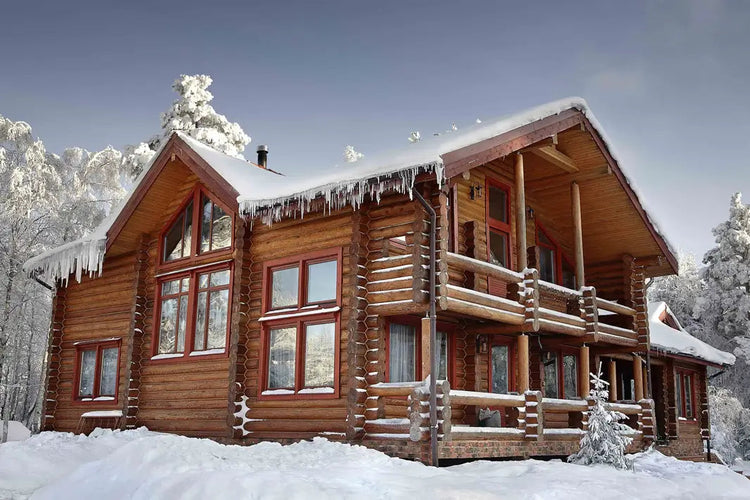Log cabins have been an iconic symbol of rustic living for centuries. They provide warmth, charm, and comfort that can't be found in any other type of home. But as beautiful as they are, these homes require regular maintenance, including log cabin chinking, to keep them in good condition.
Log chinking is one of the most essential aspects of log cabin maintenance. It adds to the home's aesthetic appeal and plays a crucial role in protecting it from the elements. In this how-to blog, we will guide you through chinking a log cabin, providing tips and tricks for achieving a flawless finish that will keep your home looking great for years.
What Is Log Cabin Chinking?
Log cabin chinking is the process of filling the gaps between the logs in the home. It requires specific chinking materials and chinking equipment, along with some more familiar tools. The material used for chinking can vary, but it's typically a specialized sealant that can expand and contract with the logs as they shift over time.
Why Is Log Chinking Important?
Log chinking is essential because it protects against air and water infiltration, which can severely damage the structure. Without properly chinked logs, air can enter the cabin through gaps, causing drafts and making it more challenging to maintain a consistent indoor temperature.
Moisture can also seep in, leading to rot and decay of the logs, which can compromise the cabin's structural integrity. Additionally, chinking a log home can help to keep pests, such as insects and rodents, from entering the cabin through gaps. Properly installed log chinking can also improve the energy efficiency of the cabin, potentially leading to lower heating and cooling costs.
What Do You Use to Chink a Log Cabin?
Before discussing log chinking techniques, let's review what you use to chink a log cabin. The materials and tools needed for log cabin chinking can vary depending on the size and condition of the gaps between the logs. Typically, you need:
- Backer rod, a foam material that fills larger gaps
- Chinking material, available in 5-gallon buckets and 30-ounce tubes
- Snorkler Pumping System or bulk loading guns, if using 5-gallon pails
- Caulk gun, if using tubes
- Wire brush for cleaning the gaps between the logs
- Spray water bottle to wet the logs before applying the chinking material
- Ordinary masonry-type tooling blade or a polyethylene foam brush for tooling
One of the log chinking materials we recommend is Log Jam chinking because it:
- Resembles traditional mortar, thanks to its texturing
- Provides superior elasticity
- Holds a fire-resistance rating (the only log home chinking to do so)
- Comes in several stock colors
- Is paintable and stainable
How Much Chinking Do I Need?
The amount of chinking you need depends on the size of your log cabin and the size of the chinking joints. A 5-gallon bucket of chinking will be suitable for 195 lineal feet for 1-inch chinking joints. For a larger 4-inch chinking joint, a 5-gallon bucket would last 45 lineal feet. It's essential to estimate how much log cabin chinking sealant you will need.
Coverage Rates per 5-Gallon Bucket of Chinking:
- 1" wide chinking joint= 195 lineal feet
- 2" wide chinking joint= 95 lineal feet
- 3" wide chinking joint= 65 lineal feet
- 4" wide chinking joint= 45 lineal feet
Coverage Rates per Case of 30-oz. Tubes of Chinking:
- 1" wide chinking joint= 89 lineal feet
- 2" wide chinking joint= 43 lineal feet
- 3" wide chinking joint= 30 lineal feet
- 4" wide chinking joint= 20 lineal feet
How to Chink a Log Cabin
Before beginning your log cabin chinking, you should stain your logs. You'll get the best results if you apply chinking to wood that has been previously coated with a compatible stain. If newly stained, the coating should be thoroughly cured before the chinking application.
Other steps in chinking a log home include:
1. Consider the Weather and Temperature
If you're chinking a log cabin, you must gauge the weather conditions. This is crucial for a few reasons:
Sunlight
You shouldn't apply your chinking sealant in direct sunlight. Direct sunlight can lead to "blistering," which can hurt the overall effectiveness of your chinking. After laying your chinking, cover the area for one to two days with white plastic sheeting.
Temperature
The temperature of your wood surface is also an essential factor in log chinking. Wood surfaces should be between 40 and 90 degrees. They also need to be free of frost before chinking.
Your 5-gallon buckets of chinking also need to be at an appropriate temperature. Leave your buckets in an area where they can warm to room temperature. Once they have reached room temperature, the chinking is ready to apply.
If the natural weather conditions don't cooperate, you can create the optimal environment. Use plastic sheeting to create a tent-like structure. You can use portable heaters to heat the area and make your wood the perfect temperature. But please be cautious when using portable heaters.
2. Clean the Logs
Clean the log surfaces thoroughly to remove dirt, pollen, bird droppings, and other contaminants.
3. Use Backer Rod
Next, apply backer rod, which provides support for chinking and sealants. Its primary purpose is to act as a "bond-breaker" and promote two-point adhesion, giving the joint and sealing material the ability to compress and expand as logs move. Chinking doesn't adhere to the backer rod — only to the log surfaces of the joint — allowing for movement without damaging the sealing material.
4. Apply Chinking
Lay a line of chinking between each pair of logs. Western Log Home Supply can provide pumping systems, grout bags, and bulk loading guns for your log cabin chinking.
5. Tool the Chinking
You should tool chinking directly after application to ensure good adhesion and a smooth-looking bead. You can use an ordinary masonry-type tooling blade, a damp polyethylene foam brush or even a wet finger.
Work the material smooth, tooling it tightly to the surface of each chinked log.
6. Clean Up
Clean-up is simple — just keep a damp rag handy to wipe up excess chinking.
Western Log Home Supply is the go-to source of log cabin chinking materials and tools. If you're interested in chinking a log home, we have all the supplies you need, along with answers to any of your questions. For more information about log chinking materials, application processes or tools, call us toll-free at (888) 307-3327.
Blog
Articles Related to Log Cabin Chinking

Learn all about your options when it comes to log cabin chinking materials.

Discover everything you need to know about filling cracks and checks.

Find out why backer rod is a crucial component of any log chinking project.


